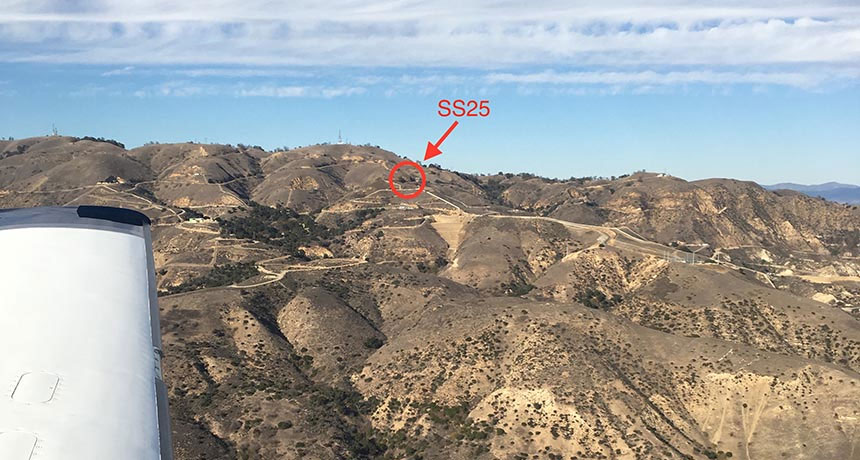Enormous natural-gas leak polluted L.A. air
A massive release of greenhouse gases went unchecked for more than three months

Aliso Canyon well SS25 (labeled in red) released enormous amounts of methane into the air above the Los Angeles Basin, new data show.
Stephen Conley
Over many millions of years, gases, such as methane, tend to develop along with crude oil in natural deposits of petroleum. On October 23, a natural-gas well in California’s San Fernando Valley began leaking huge quantities of methane and another natural gas, ethane. The pollution didn’t stop until workers finally sealed the leaky pipe on February 18. Over that time, the leak became the second largest, concentrated leak of stored methane — a potent greenhouse gas — in U.S. history.
The leak occurred in one of the wells at the Aliso Canyon oil storage facility. The affected well was originally drilled in the 1950s to produce crude oil. Two decades later, it was converted into an underground gas-storage site.
In all, an estimated 97,100 metric tons (107,000 U.S. short tons) of methane and 7,300 metric tons of ethane escaped into the air above Los Angeles. That volume of gas is equal to the yearly methane releases of medium-sized countries in Europe. And the greenhouse effect of that methane over the next century (it is a long-lasting gas) is about equal to that from the greenhouse-gas emissions of 572,000 U.S. cars.Researchers reported the numbers February 25 in Science.
Methane and ethane both increase levels of smog ozone near the ground. That smog can harm human health. So Stephen Conley of the University of California-Davis and his colleagues decided to measure natural-gas levels in the air downwind of the leak. They collected some samples near the ground. Small planes collected other samples high in the air during 13 flights as the well leaked.
At its peak, during the first six weeks of the leak, the well spewed some 59 metric tons (65 short tons) of methane and 4.4 metric tons of ethane per hour, the researchers now say. That’s twice the normal release of these gases over the entire 2,590 square-kilometer (1,000 square-mile) Los Angeles Basin.
Los Angeles is home to many smaller natural-gas leaks, another group reported on February 20. They mapped methane releases across the Los Angeles Basin before the big leak. And they turned up 213 hotspots. The sources of those leaks remain unknown.
Francesca Hopkins and her colleagues shared their findings February 20 in the Journal of Geophysical Research: Atmospheres. Maps such as theirs could help researchers put the bigger methane leak into perspective, they say.
Power Words
(for more about Power Words, click here)
crude oil Petroleum in the form as it comes out of the ground.
geophysics (adj. geophysical) The branch of science that deals with the physical properties of the Earth. It uses the principles and laws of physics to interpret the internal internal structure, magnetic and gravitational fields, climate, atmosphere, oceans, sea ice and land forms. People who work in this field are known as geophysicists. They study Earth’s features by measuring seismic (acoustic), gravitational, electrical and magnetic properties.
greenhouse gas A gas that contributes to the greenhouse effect by absorbing heat. Carbon dioxide is one example of a greenhouse gas.
methane A hydrocarbon with the chemical formula CH4(meaning there are four hydrogen atoms bound to one carbon atom). It’s a natural constituent of what’s known as natural gas. It’s also emitted by decomposing plant material in wetlands and is belched out by cows and other ruminant livestock. From a climate perspective, methane is 20 times more potent than carbon dioxide is in trapping heat in Earth’s atmosphere, making it a very important greenhouse gas.
natural gas A mix of gases that developed underground over millions of years (often in association with crude oil). Most natural gas starts out as 50 to 90 percent methane, along with small amounts of heavier hydrocarbons, such as propane and butane.
ozone A colorless gas that forms high in the atmosphere and at ground level. When it forms at Earth’s surface, ozone is a pollutant that irritates eyes and lungs. It is also a major ingredient of smog.
smog A kind of pollution that develops when chemicals react in the air. The word comes from a blend of “smoke” and “fog,” and was coined to describe pollution from burning fossil fuels on cold, damp days. Another kind of smog, which usually looks brown, develops when pollutants from cars react with sunlight in the atmosphere on hot days.







